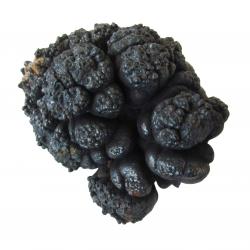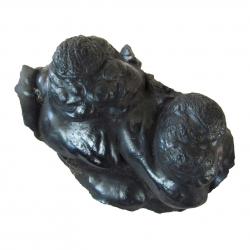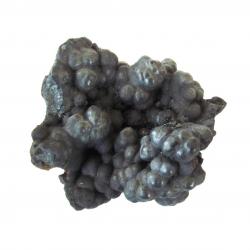Sign up for Lesson Plans, discounts & more!
Goethite
Goethite is a common mineral that belongs to the oxide group. It has the chemical formula FeO(OH) and often contains varying amounts of other elements such as aluminum, manganese, and titanium. It is named after German poet and playwright Johann Wolfgang von Goethe.


Goethite is named after Johann Wolfgang von Goethe to honor his contributions to literature, natural science, and mineralogy. Johann Wolfgang von Goethe (1749-1832) was a prominent German poet, playwright, novelist, and philosopher. During his lifetime, Goethe had a keen interest in geology and mineralogy. He made significant contributions to the understanding of minerals and their formation through his observations and writings. Additionally, he maintained correspondence with notable mineralogists of his time and actively collected minerals. Goethe's passion for minerals and his role in promoting mineralogy as an academic discipline led to several minerals being named after him. Goethite was one of them, named by the German mineralogist Johann Georg Lenz in 1806, who recognized the importance of Goethe's work in the field.
Goethite typically occurs in a variety of environments, including sedimentary, metamorphic, and hydrothermal settings. It forms as a secondary mineral through the oxidation of primary iron minerals. It is often found in bogs, swamps, marshes, and other wet environments, where it can accumulate as concretions or coatings on rocks and other materials.
This mineral is commonly found in various forms such as concretions, stalactitic formations, oolites (aggregates of small round grains bound together), reniform shapes resembling kidneys, or accumulations with a botryoidal appearance (resembling clusters of grapes). Goethite often exhibits a rusty-brown to dark-brown color, although it can also range from yellowish-brown to black. It has a hardness of 5-5.5 on the Mohs scale, making it relatively soft compared to many other minerals.


Throughout history, goethite has been used for various purposes. In ancient times, it was employed as a pigment. Goethite pigments were commonly used by Paleolithic and Neolithic peoples for cave paintings and rock art.
Goethite is an important mineral in soil formation and plays a key role in the weathering of iron-bearing rocks. It is also a common constituent of iron ores, including banded iron formations, which were deposited during the Archean and Proterozoic Eons.
Goethite has several notable physical properties. It possesses a brown streak, a submetallic-to-earthy luster, and a specific gravity of around 3.3 to 4.3. Under the right conditions, it may exhibit weak fluorescence under ultraviolet light.
In addition to its aesthetic appeal, goethite is known for exhibiting interesting pseudomorphs. Pseudomorphs are minerals that retain the external shape of their precursor minerals but have a different internal crystal structure. Goethite can pseudomorph minerals such as pyrite, marcasite, siderite, and gypsum.
Goethite is often associated with other iron minerals, such as hematite and magnetite. These minerals can form together in complex patterns, creating colorful and intricate mineral specimens that are highly sought after by mineral collectors.
Goethite has several industrial applications. It is used as an iron ore, primarily because of its high iron content. It is also employed as a pigment in paints, ceramic glazes, and cosmetics. When finely ground, goethite produces a golden brown pigment known as "brown ochre."
Goethite & The Environment
The formation of goethite is influenced by various environmental factors, including temperature, pH, and the availability of iron and oxygen. As a result, its presence can provide valuable information about past environmental conditions, making it an important tool for scientists studying Earth's history.
In recent years, goethite has garnered attention for its potential uses in environmental remediation. Its unique properties, such as its ability to adsorb heavy metals and contaminants, make it a promising material for water purification and soil remediation applications.
Goethite has garnered attention for its potential uses in environmental remediation due to its properties that make it an effective adsorbent for pollutants and contaminants. Some reasons why goethite is studied for remediation purposes include:
1. Adsorption capabilities: Goethite has a high surface area and abundant reactive sites, allowing it to adsorb various pollutants. It can effectively adsorb heavy metals like lead, arsenic, and cadmium, as well as organic compounds such as dyes, pesticides, and hydrocarbons.
2. Stability: Goethite is chemically stable under a wide range of environmental conditions. It does not undergo significant dissolution or transformations, ensuring its integrity and longevity as an adsorbent.
3. Selectivity: Goethite exhibits selectivity in adsorbing specific contaminants. Its surface properties can be modified to target particular pollutants, making it a versatile material for different remediation applications.
4. Abundance and low cost: Goethite is a common iron oxyhydroxide mineral found in various geological formations. Its abundance and low cost make it an attractive option for large-scale remediation projects.
Due to these properties, goethite has been investigated for the removal of contaminants from wastewater, groundwater, and soil. Research has focused on optimizing its adsorption capacity, understanding the underlying mechanisms, and exploring ways to enhance its performance through surface modifications or composite formations with other materials.
While goethite shows promise in environmental remediation, further research is needed to fully understand its limitations, optimize its application, and ensure its effectiveness in real-world scenarios. WOW!
Goethite in Science
Goethite is also an important mineral for scientific research. Its crystal structure and properties have been extensively studied, providing valuable insights into the behavior of minerals under different conditions.
Goethite has provided insights and contributed to scientific research in several fields. Here are some notable examples:
- Soil science: Goethite plays a crucial role in soil formation and nutrient cycling. By studying goethite, scientists gain insights into soil processes such as weathering, mineral transformations, and the availability of essential elements for plants. Understanding these processes is significant for sustainable agricultural practices and soil management.
- Geological exploration: In the field of geology, goethite is a common mineral found in various geological settings. Its presence can indicate specific mineralization patterns, hydrothermal processes, or the evolution of geological formations. Therefore, its identification and analysis contribute to mineral exploration and understanding geological history.
- Geochemistry and biogeochemistry: The properties of goethite, such as its ability to adsorb metals and other substances, make it relevant to geochemical and biogeochemical studies. It helps researchers understand the behavior and fate of contaminants in natural systems, including their transport, bioavailability, and potential impact on ecosystems.
- Magnetism and paleomagnetism: Goethite can exhibit weak ferromagnetism, which has implications in the field of magnetism and paleomagnetism. Scientists use goethite to study the Earth's magnetic field history preserved in rocks and sediments, allowing them to reconstruct past geological events and changes in the Earth's magnetic field over time.
- Material science and nanotechnology: Goethite nanoparticles have attracted interest in material science and nanotechnology. Their unique magnetic properties and high surface area make them useful in various applications, such as in catalysis, drug delivery systems, and magnetic storage devices.
These are just a few examples of the insights goethite has provided in scientific research. Its diverse properties and prevalence have made it a valuable mineral for understanding various natural processes and developing innovative applications in different fields of study.
~~~
Geologically, goethite can be found all around the world. It occurs in significant quantities in various countries, including Brazil, Australia, the United States, Germany, Russia, and South Africa.
In terms of its metaphysical properties, goethite is believed to enhance creativity, intuition, and spiritual growth. It is said to have a grounding and calming effect, promoting emotional stability and self-discovery.
In summary, goethite is a common mineral that occurs in various geological environments. Its earthy appearance, pseudomorphs, and industrial applications make it an intriguing mineral for both scientists and enthusiasts. Whether it is admired for its aesthetics, studied for its geological significance, or utilized for its practical uses, goethite holds a significant place in the realms of mineralogy and Earth sciences.
Here are a bevy of fun facts about goethite:
1.Goethite is commonly found as a mineral in soils, sedimentary rocks, caves, and hydrothermal deposits.
2. It often forms in mammillary or botryoidal crystal aggregates, resembling groups of rusty spheres or kidney-like shapes.
3. Goethite has a distinctive yellow to brownish-red color and can sometimes exhibit iridescent shades.
4. Due to its appearance, goethite is sometimes called "the golden mineral" or "the iron rose."
5. Goethite is one of the main components of ochre pigments, which have been used for thousands of years in cave paintings, rock art, and other artistic applications.
6. It can be found on Mars! NASA's Opportunity rover discovered goethite-rich deposits on the red planet, suggesting the presence of liquid water in the past.
7. Goethite has been used as a gemstone, although it is relatively soft and not as popular as other minerals like quartz or garnet.
8. One famous occurrence of goethite is in the Iron Mountain mine in California, known for its stunning iridescent botryoidal formations called "Fire Agates."
9. Goethite is paramagnetic, meaning it can be weakly magnetized when exposed to an external magnetic field.
10. It is often associated with other iron minerals, such as hematite and magnetite, in various geological formations.
11. Goethite exhibits piezoelectricity, which means it can generate an electrical charge when subjected to mechanical stress.
12. It has been found as a component of natural pigments used in ancient Egyptian tomb paintings and medieval manuscripts.
13. Goethite is composed of iron, oxygen, and hydrogen, with a chemical formula FeO(OH).
14. Some goethite specimens contain fossilized plant or insect remains trapped during the mineral's formation, providing a glimpse into ancient ecosystems.
These fun facts highlight the interesting aspects of goethite, showcasing its diverse roles in geology, art, and even extraterrestrial exploration!
Want to own your own piece of Goethite? https://www.fossilicious.com/goethite/

INTERESTED IN MORE? IF SO, YOU MAY WANT TO CHECK OUT OUR OTHER SITES:
fossilicious.com - Our online fossil and mineral rock shop.
fossils-facts-and-finds.com - An educational site about fossils.











